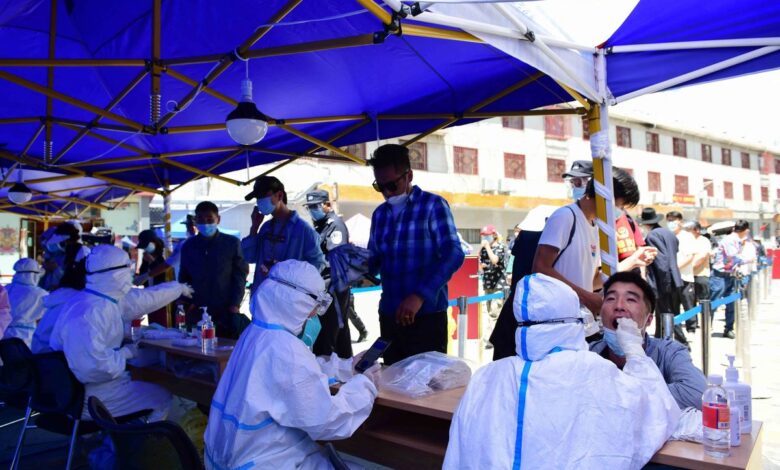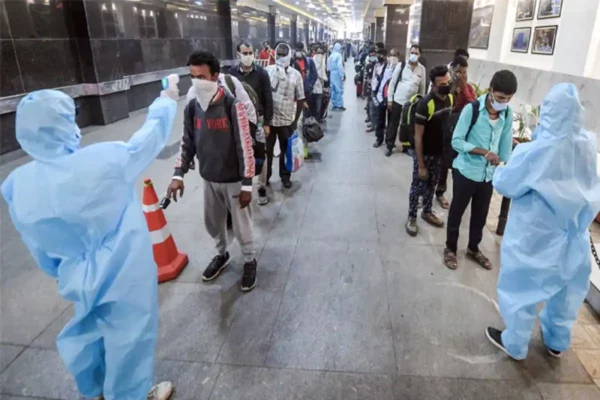China reported 37 million instances of Covid in a day. How reliable are the COVID-19 death estimates from China?

China reported 37 million instances of Covid in a day. How reliable are the COVID-19 death estimates from China?
Foreign health experts caution that China’s strict standards for classifying COVID-19-related deaths will understate the exact toll of the pandemic’s current wave there and may make it more challenging to spread information about the most effective personal protection measures. According to a top Chinese medical expert, only deaths brought on by pneumonia and respiratory failure following COVID will be considered coronavirus-related.
According to Wang Guiqiang, chief of the infectious disease division at Peking University First Hospital, deaths from complications in other areas of the body, such as underlying diseases rendered worse by the virus, would not be counted in the official toll.
What’s happening right now in China?

According to specialists familiar with hospital regulations in China, such situations were not always disregarded in the past, nevertheless, COVID was occasionally overlooked as a cause of death if a patient who had previously tested positive had tested negative a day or two before passing away.
The Omicron variation is less likely to generate additional life-threatening symptoms, according to Wang, but China’s hospitals are still forced to analyze each case to determine with certainty whether or not COVID was the underlying cause. In the nearly three years after the pandemic started, different countries have used different techniques for counting COVID mortality.
However, illness experts outside of China claim that this particular strategy will ignore a number of other widely acknowledged COVID problems that can be lethal, including blood clots, heart attacks, sepsis, and renal failure.
Some of these issues can raise the risk of passing away at home, especially for those who are unaware that they should seek medical attention if they have these symptoms.
Dr. Aaron Glatt, an infectious diseases specialist at Mount Sinai South Nassau Hospital in Revised York and a representative for the Infectious Diseases Society of America, remarked that “surely [the new criteria] will not identify all COVID fatalities.” You can’t just choose to ignore everything else your body is doing, because that’s both scientifically inaccurate and irrational.
According to a study published this month in Korea, pneumonia was not the cause of 33% of Omicron-related deaths that happened at a major hospital between July 2021 and March 2022.
Does China have reliable covid data?

China has been frequently blamed for exaggerating infections and fatalities for political purposes despite having one of the least COVID death rates in the world.
A June 2020 assessment of the nation’s initial outbreak in Wuhan beginning in late 2019 found that 36,000 deaths, or ten times the official number, may have happened at the time.
According to research published in the Lancet in April that examined COVID-related mortality in 74 nations and territories from 2020 to 2021, there were 17,900 additional deaths in China during that time period as opposed to the country’s 4,820 official death toll.
Globally, the study predicted 18.2 million more deaths in 2021–2022, contrary to the 5.94 million COVID deaths that were officially reported. The latest declaration from China sparked concerns that the administration was attempting to hide the true effects of loosening its strict “zero-COVID” rules following almost three years of upsetting lockdowns and required mass testing.
No new fatalities were reported on December 21 and only seven deaths were reported since the government stated on December 8 that “zero-COVID” restrictions would be lifted, in spite of widespread claims that funeral homes and crematoriums are having trouble keeping up with an increase in demand.
What does the data currently indicate?
On December 20, China’s death toll was actually reduced by one, bringing it to 5,241. Requests for comment regarding the COVID numbers and excess mortality in China were not immediately answered by the National Health Commission of China.
Given how swiftly infections are already spreading, even if China were to continue classifying COVID deaths more broadly, Chen Jiming, a medical researcher at China’s Foshan University, said the official data is still unlikely to accurately reflect the reality on the ground.
The genuine values, he claimed, “are just a very small part of the stated counts of illnesses and deaths.” Because so little testing is being done now that China has stopped mass surveillance, according to Ben Cowling, an epidemiologist at the University of Hong Kong‘s School of Public Health, the official death toll would be very low even if a broader definition were in use.
Conversely, Cowling warned that overcounting could result from classifying every individual who passed away while testing positive for COVID as having died from the illness. Some have argued that this method “may also be challenged for adding unexpected fatalities, such as victims killed by a vehicle whilst suffering moderate COVID.”
Pathologist at Washington University in St. Louis Dr. Mai He, who participated in the 2020 Wuhan research, says that skepticism remains over the accuracy of China’s official numbers. Lack of openness, he told Reuters, “is the enduring critical matter; people cannot operate their data to undertake study and analysis, (or) provide direction for the next move.”
Public concern is also being brought on by the public’s lack of confidence in China’s data, according to Victoria Fan, senior fellow in global health at the Center for Global Development. Because many of the behaviors the public displays are a result of a lack of knowledge, she added, it is in the government’s best interest to be more transparent.
China’s outbreak is the largest in the world, impacting 37 million people every day.

According to estimates from the government’s main health authority, around 37 million people in China may have contracted Covid-19 on a single day this week, making the country’s outbreak by far the greatest in the world.
According to minutes from an executive session of China’s National Health Commission conducted on Wednesday, which was validated by officials who participated in the discussions, as many as 248 million people, or nearly 18% of the population, possibly caught the virus in the first 20 days of December. If confirmed, this would mean that the current daily number of infections is significantly higher than the all-time high of 4 million cases set in January 2022.
The quick removal of Covid Zerorestrictions by Beijing has allowed the extremely infectious omicron forms to spread unchecked in a population with poor levels of natural immunity. Official statistics suggest that in Beijing and Sichuan regions in southwestern China, almost half of the population is afflicted with some form of illness.
Given that the nation’s formerly extensive network of PCR testing booths was shut down earlier this month, it is unclear how the Chinese health agency arrived at its estimate. Since home testing with findings that weren’t centralized collected replaced difficult-to-get laboratory tests during the pandemic, precise infection rates have been challenging to establish in other countries.
The NHC was unable to return a fax from Bloomberg News requesting information. On Friday, no voicemails nor emails were returned from the commission’s National Disease Control Bureau, the unit responsible for coordinating the reaction to the Covid outbreak.
Rapid antigen tests are increasingly used in China to identify infections, and users are not required to disclose positive results. The government has ceased reporting the daily total of asymptomatic cases in the meantime.
Based on a review of online keyword searches, Chen Qin, chief economist at data consultancy MetroDataTech, predicts that the current wave in China would peak in the majority of cities between mid-December and late January. His estimate indicates that the reopening boom is already to blame for tens of millions of infections every day, with Shenzhen, Shanghai, and Chongqing having the highest case counts.
Unreported Deaths
The number of deaths was not discussed during the meeting and is not recorded in the minutes. Ma Xiaowei, the head of the NHC, was cited in support of the new, considerably more specific criteria that were used to count Covid deaths. He emphasized that only patients who pass away from Covid-induced pneumonia should be included in the mortality numbers, despite the fact that deaths will unavoidably happen given how quickly the infection is spreading.
Beijing, the city that was first affected, is now experiencing severe and serious Covid cases, according to officials, even if the city’s overall infection incidence is declining. In the meantime, the pandemic is moving from metropolitan areas to rural China, where there are frequently few medical supplies. Every region was reported by the organization to get ready for an uptick in serious illnesses.
There were only 3,049 cases of sickness reported to the Chinese government on December 20th, a far cry from the 37 million cases that were expected. Furthermore, it significantly surpasses the prior disease outbreak record holder. According to data provided by Bloomberg, the number of cases worldwide peaked at 4 million on January 19, 2022, during the first wave of omicron infections that followed its introduction in South Africa.
The severity of the illness indicated by the government estimates highlights the difficulty China now faces after abruptly departing from the Covid Zero program that had mostly contained the virus for the previous three years. Healthcare in prominent Chinese cities including Beijing and Shanghai increasingly overcrowded due to the unexpected inflow of patients, and funeral homes are struggling to cope with the increasing body count.




